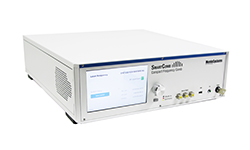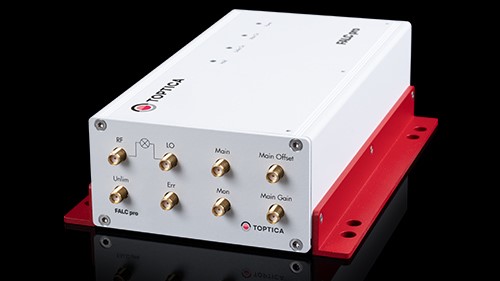optical metrology (original) (raw)
Definition: the science and technology of performing measurements with light
- optical metrology
- autocollimators
- beam profilers
- colorimeters
- colorimetry
- frequency metrology
- laser beam characterization
- optical energy meters
- optical frequency standards
- optical power meters
- optical power monitors
- optical profilometers
- optical spectrum analyzers
- optical time-domain reflectometers
- powermeters
- photometry
- polarimeters
- refractometers
- spectrographs
- spectrometers
- spectrophotometers
- wavemeters
- (more topics)
Related: lightfrequency metrologyoptical clocksinterferometersdistance measurements with lasersreflectometersoptical profilometerslaser noisespectrometerswavemetersradiometryphotometry
Page views in 12 months: 1244
DOI: 10.61835/0p9 Cite the article: BibTex BibLaTex plain textHTML Link to this page! LinkedIn
Content quality and neutrality are maintained according to our editorial policy.
📦 For purchasing optical metrology, use the RP Photonics Buyer's Guide — an expert-curated directory for finding all relevant suppliers, which also offers advanced purchasing assistance.
Contents
What is Optical Metrology
Optical metrology is the science and technology concerning measurements with light. Such measurements can either target properties of light and light sources or properties of objects such as dimensions, distances and temperatures. There is no strict boundary between those fields because often one uses measured properties of light not just to characterize a light source, but for other purposes — for example, optical frequency metrology is used for ultraprecise optical clocks.
Some examples of optical metrology are:
- Optical distance measurements with lasers can be based on, e.g., interferometers or measurements of the time-of-flight of light pulses. This is an example of dimensional metrology.
- Highly precise angular measurements are possible with autocollimators, particularly with electronic autocollimators based on lasers.
- Optical profilometers are widely used for measuring surface topographies, e.g. in semiconductor chip production and for the quality control in optical fabrication. Form metrology also uses various other kinds of instruments for measuring surface shape (contour) and surface roughness.
- Optical time-domain reflectometers are used for inspecting fiber-optic links — for example, finding faulty fiber splices or fiber connectors. Free-space reflectometers are used e.g. for characterizing thin-film optical devices.
- optical powers can be measured with photodiodes, thermal power meters, or other equipment. Optical irradiance and other illumination measurements can address either some pure physical quantity such as an optical intensity (power per unit area) (radiometry) or something like a perceived brightness (photometry). Integrating spheres are utilized for radiation emitted in a wide range of direction.
- Spectral optical properties are measured with devices like spectrographs or other spectrometers, wavemeters and self-heterodyne setups.
- Optical frequency metrology deals with high-precision measurements of optical frequencies. One can produce ultraprecise optical clocks, surpassing the performance of cesium atomic clocks.
- Optical temperature sensors may be based on the analysis of the thermal emission of hot bodies, or rely on the measurement of occupation probabilities for energy levels of atoms or molecules.
- Fiber-optic temperature and strain sensors allow for distributed sensing, often of temperature and strain combined. They can be used, for example, for measurements in industrial processing plants, bridges and tunnels, buildings, oil and gas pipelines and power transmission lines.
Optical metrology uses a wide range of measurement instruments. For calibrating those, special calibration light sources are required, providing light with well-defined properties like optical power, luminance or wavelength, for example. For example, there are certain spectral lamps providing quasi-monochromatic light with a precisely defined wavelength.
Typical Qualities of Optical Metrology
In many cases, optical metrology can be extremely precise and is ultimately limited by laser noise or quantum noise in detection.
Optical measurements are usually quite fast and suitable e.g. for in-process metrology, i.e., for monitoring industrial production processes.
Generally, optical measurements are non-destructive. Even very sensitive parts can be checked without touching them (non-contact methods), i.e., without a risk of damage.
Special Challenges
Obviously, optical metrology becomes particularly challenging when extremely high precision is required. However, the magnitude of that challenge also depends on the circumstances. For example, particularly sophisticated metrology is required for characterizing very large optics. Some traditional techniques can they not be used or need to be specially adapted.
Suppliers
Sponsored content: The RP Photonics Buyer's Guide contains 66 suppliers for optical metrology. Among them:
⚙ hardware🧩 accessories and parts🔧 maintenance, repair📏 metrology, calibration, testing💡 consulting🧰 development🎓 training💻 software
As a leading manufacturer of light measurement technology, measurement quality takes top priority at Instrument Systems. To this end, we operate an accredited testing laboratory at our facilities in Munich and Berlin. All measuring instruments produced by us are subjected to a detailed quality check, and their results are documented in test certificates. Our portfolio for your audit includes System Auditing, Audit for Cameras & Spectrometers and LED Calibration Standards.
⚙ hardware
Optical interrogators for accurate and precise measurements of Fiber Bragg Grating signals.
Suitable for large scale sensing networks, HBK FiberSensing interrogators provide precise and high resolution static and dynamic measurements 24/7 through reliable software interfaces.
Compatibility with catman software enables hybrid optical/electrical sensing to be easily managed.
⚙ hardware
The optical frequency discriminator (OFD) system of SILENTSYS smartly delivers a voltage signal that is proportional to the fluctuations of the optical frequency of the input laser beam. This turn-key module is suitable for laser frequency noise characterization and/or for laser frequency stabilization to drastically reduce its optical linewidth. The OFD features ultralow noise performances being successful in achieving frequency noise level as low as 0.01 Hz²/Hz with >60 dB noise reduction, and that is achieved in a compact and user-friendly package.
This product is available in a huge wavelength range from UV, VIS to NIR, with one or two optical modules inside to be a very versatile tool.
The optical frequency correlator (OFC) system contains a common 2-input optical frequency discriminator (OFD). This makes it possible to frequency.stabilize two wavelength distant lasers onto the same optical reference in order to reduce their frequency fluctuations and to correlate them precisely.
Based on this fact, the optical beat frequency between the two stabilized lasers generates THz or GHz signals that reach a very low frequency noise level and are easily frequency tunable. Moreover, as a standard OFD, it smartly delivers a voltage signal that is proportional to the frequency fluctuations of the input laser beam. This turn-key device is suitable for laser frequency noise characterization and/or for laser frequency stabilization.
⚙ hardware
As the pioneer in the optical frequency comb technology, Menlo Systems offers a full product line from the compact and fully automated SmartComb to the ultra-low noise optical frequency comb FC1500-ULNplus. Our patented figure 9® mode locking technology ensures lowest phase noise and long-term reliable operation.
⚙ hardware
EssentOptics develops and manufactures high-performance spectrophotometers for advanced optical metrology and thin-film characterization. The PHOTON RT and LINZA series provide broadband transmission and reflection measurements from DUV to LWIR with variable angle and polarization control. They enable accurate analysis of optical coatings and coated components — from flats and gratings to spherical and aspheric lenses — under realistic, field-like conditions. All systems operate fully unattended, ensuring fast, repeatable, and reliable performance for demanding optical measurement tasks.
⚙ hardware📏 metrology, calibration, testing
At Avantier Inc, we design optical solutions systems and produce high performance optics for optical metrology equipment for a wide variety of applications. We work at the forefront of research and developments, and produce metrology systems for research, industry, aerospace, and defense.
⚙ hardware
TOPTICA offers laser sources for various applications and optical metrology, including time and frequency measurements, tests of fundamental constants and tests of fundamental theories, a term interferometry, laser-based trace gas analysis, and the measurement of smallest magnetic fields.
The high precision measurements that are mentioned here require tunable lasers, most of the time with very narrow linewidth and long term stability. In addition, special electronics modules are needed to perform reliable and most advanced laser stabilization. Photonicals — additional laser related accessories — help to characterize or to manipulate the laser light. Many, if not most experiments mentioned here already successfully use our products.
Questions and Comments from Users
Here you can submit questions and comments. As far as they get accepted by the author, they will appear above this paragraph together with the author’s answer. The author will decide on acceptance based on certain criteria. Essentially, the issue must be of sufficiently broad interest.
Please do not enter personal data here. (See also our privacy declaration.) If you wish to receive personal feedback or consultancy from the author, please contact him, e.g. via e-mail.
By submitting the information, you give your consent to the potential publication of your inputs on our website according to our rules. (If you later retract your consent, we will delete those inputs.) As your inputs are first reviewed by the author, they may be published with some delay.
 optical metrology
optical metrology










